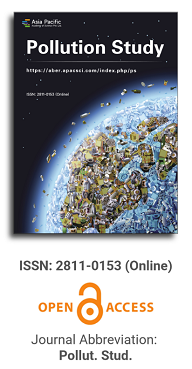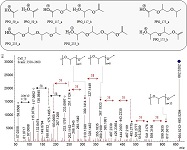
Asia Pacific Academy of Science Pte. Ltd. (APACSCI) specializes in international journal publishing. APACSCI adopts the open access publishing model and provides an important communication bridge for academic groups whose interest fields include engineering, technology, medicine, computer, mathematics, agriculture and forestry, and environment.

The (partial) replacement of synthetic polymers with bioplastics is due to increased production of conventional packaging plastics causing for severe environmental pollution with plastics waste. The bioplastics, however, represent complex mixtures of known and unknown (bio)polymers, fillers, plasticizers, stabilizers, flame retardant, pigments, antioxidants, hydrophobic polymers such as poly(lactic acid), polyethylene, polyesters, glycol, or poly(butylene succinate), and little is known of their chemical safety for both the environment and the human health. Polymerization reactions of bioplastics can produce no intentionally added chemicals to the bulk material, which could be toxic, as well. When polymers are used to food packing, then the latter chemicals could also migrate from the polymer to food. This fact compromises the safety for consumers, as well. The scarce data on chemical safety of bioplastics makes a gap in knowledge of their toxicity to humans and environment. Thus, development of exact analytical protocols for determining chemicals of bioplastics in environmental and food samples as well as packing polymers can only provide warrant for reliable conclusive evidence of their safety for both the human health and the environment. The task is compulsory according to legislation Directives valid to environmental protection, food control, and assessment of the risk to human health. The quantitative and structural determination of analytes is primary research task of analysis of polymers. The methods of mass spectrometry are fruitfully used for these purposes. Methodological development of exact analytical mass spectrometric tools for reliable structural analysis of bioplastics only guarantees their safety, efficacy, and quality to both humans and environment. This study, first, highlights innovative stochastic dynamics equations processing exactly mass spectrometric measurands and, thus, producing exact analyte quantification and 3D molecular and electronic structural analyses. There are determined synthetic polymers such as poly(ethylenglycol), poly(propylene glycol), and polyisoprene as well as biopolymers in bags for foodstuffs made from renewable cellulose and starch, and containing, in total within the 20,416–17,495 chemicals per sample of the composite biopolymers. Advantages of complementary employment in mass spectrometric methods and Fourier transform infrared spectroscopy is highlighted. The study utilizes ultra-high resolution electrospray ionization mass spectrometric and Fourier transform infrared spectroscopic data on biodegradable plastics bags for foodstuffs; high accuracy quantum chemical static methods, molecular dynamics; and chemometrics. There is achieved method performance |r| = 0.99981 determining poly(propylene glycol) in bag for foodstuff containing 20,416 species and using stochastic dynamics mass spectrometric formulas. The results highlight their great capability and applicability to the analytical science as well as relevance to both the fundamental research and to the industry.
Characteristics of water quality and estimation of pollution loads in the main rivers surrounding Erhai Lake
Vol 4, Issue 2, 2023
Download PDF
Abstract
To uncover the pollution characteristics of the main rivers flowing into Erhai Lake, a study was conducted from January 2014 to December 2016, monitoring the water quality and quantity of 27 major rivers using total nitrogen (TN), total phosphorus (TP), ammonia nitrogen (NH3-N), and chemical oxygen demand (CODcr) as pollution indicators. Additionally, this study combined an analysis of precipitation data during the same period with water quality monitoring data from the lake area, detailing the water quantity and quality characteristics of the rivers entering the lake, estimating the pollution load entering the lake, and assessing the impact of this pollution load on the lake's water quality. The results indicate that: a) from 2014 to 2016, the total water inflow from the 27 main rivers into the lake ranged from 287 million to 474 million m³, with the inflow during the flood season accounting for 79.17%, 74.90%, and 61.96% of the annual total, respectively. The water inflow into the lake was positively correlated with the basin's precipitation; b) over time, pollutant concentrations exhibited a fluctuating trend, initially increasing and then decreasing throughout the year. Generally, water quality during the rainy season was good, and the spatial variation in pollutant concentrations was less pronounced than the temporal variation, with a significant negative correlation between pollutant concentrations and basin rainfall; c) the pollution load entering Erhai Lake initially decreased, then increased, and subsequently decreased again over the year. The pollution load was primarily influenced by water volume, with contribution rates ranked as north bank > west bank > southeast bank. The total nitrogen input from the rivers was positively correlated with the total nitrogen concentration in the lake area, while total phosphorus input was positively correlated with the total phosphorus concentration in the lake area, indicating that these rivers are significant sources of nitrogen and phosphorus for Erhai Lake.
Keywords
References
- Wei Z. Research on algae control technology in Erhai Lake (Chinese). Kunming: Yunnan People’s publishing house; 2013.
- Qiu Z. Health assessment of rivers entering Erhai Lake (Chinese). Suzhou: Suzhou Institute of science and technology; 2015.
- Jin X. Improvement and restoration of water environment of rivers entering the lake (Chinese). Beijing: Science Press; 2014.
- Zhang S, Li Y, Zhang T, et al. An integrated environmental decision support system for water pollution control based on TMDL—A case study in the Beiyun River watershed. Journal of Environmental Management (Chinese). 2015; 156: 31-40. doi: 10.1016/j.jenvman.2015.03.021
- Dong C, Zhang W, Ma H, et al. A magnetic record of heavy metal pollution in the Yangtze River subaqueous delta (Chinese). Science of The Total Environment. 2014; 476-477: 368-377. doi: 10.1016/j.scitotenv.2014.01.020
- Putro B, Kjeldsen TR, Hutchins MG, et al. An empirical investigation of climate and land-use effects on water quantity and quality in two urbanising catchments in the southern United Kingdom. Science of The Total Environment. 2016; 548-549: 164-172. doi: 10.1016/j.scitotenv.2015.12.132
- Yu S, Xu Z, Wu W, et al. Effect of land use types on stream water quality under seasonal variation and topographic characteristics in the Wei River basin, China (Chinese). Ecological Indicators. 2016; 60: 202-212. doi: 10.1016/j.ecolind.2015.06.029
- Wang F. A brief discussion on the water quality of the main rivers entering Erhai Lake in Dali (Chinese). 2015 annual academic meeting of Yunnan water conservancy society, Kunming; 2015. p. 12.
- Xiang S, Wan L, Pang Y. Temporal and spatial distribution law of water quality of rivers entering Erhai Lake Basin driven by land use (Chinese). Journal of Agricultural Environmental Sciences. 2020; 39(1): 160-170.
- Yan C, Zhao M, Li Z, et al. Water quality characteristics of rivers entering the lake in the north of Erhai Lake and its impact on the Northern Lake area (Chinese). Environmental engineering. 2020; 38(12): 59-65.
- Ma G. Water quality monitoring and evaluation of Shibaxi River in Cangshan, Dali, Yunnan (Chinese). People’s Yangtze River. 2012; 43(12): 68-70.
- Tao R, Zhao Y. Investigation and Analysis on water volume of eighteen streams in Cangshan, Dali, Yunnan (Chinese). People’s Yangtze River. 2015; 46(add 2): 44-47.
- Huang M. Study on water quality at the entrance of eighteen streams in Cangshan based on four river water quality evaluation methods (Chinese). Green technology. 2020(18): 112-114.
- Yu C, Chu J, Bai X, et al. Seasonal variation characteristics and main influencing factors of nitrogen and phosphorus in the lower reaches of maiju River (Chinese). Journal of ecology. 2011; 31(23): 7104-7111.
- Carpenter SR, Caraco NF, Correll DL, et al. Nonpoint pollution of surface waters with phosphorus and nitrogen. Ecological Applications. 1998; 8(3): 559-568.
- Chen DJ, Lu J, Yuan SF, et al. Spatial and temporal variations of water quality in Cao E River of eastern China (Chinese). Journal of Environmental Sciences. 2006; 18(4): 680-688.
- Dai D, Yu T, Lei K, et al. Characteristics of non-point source pollution of Qinghe River in Beijing (Chinese). Environmental science research. 2018; 31(6): 1068-1077.
Supporting Agencies
Copyright (c) 2023 Mingyu Huang
License URL: https://creativecommons.org/licenses/by/4.0

This site is licensed under a Creative Commons Attribution 4.0 International License (CC BY 4.0).
.jpg)
Beijing University of Technology, China



